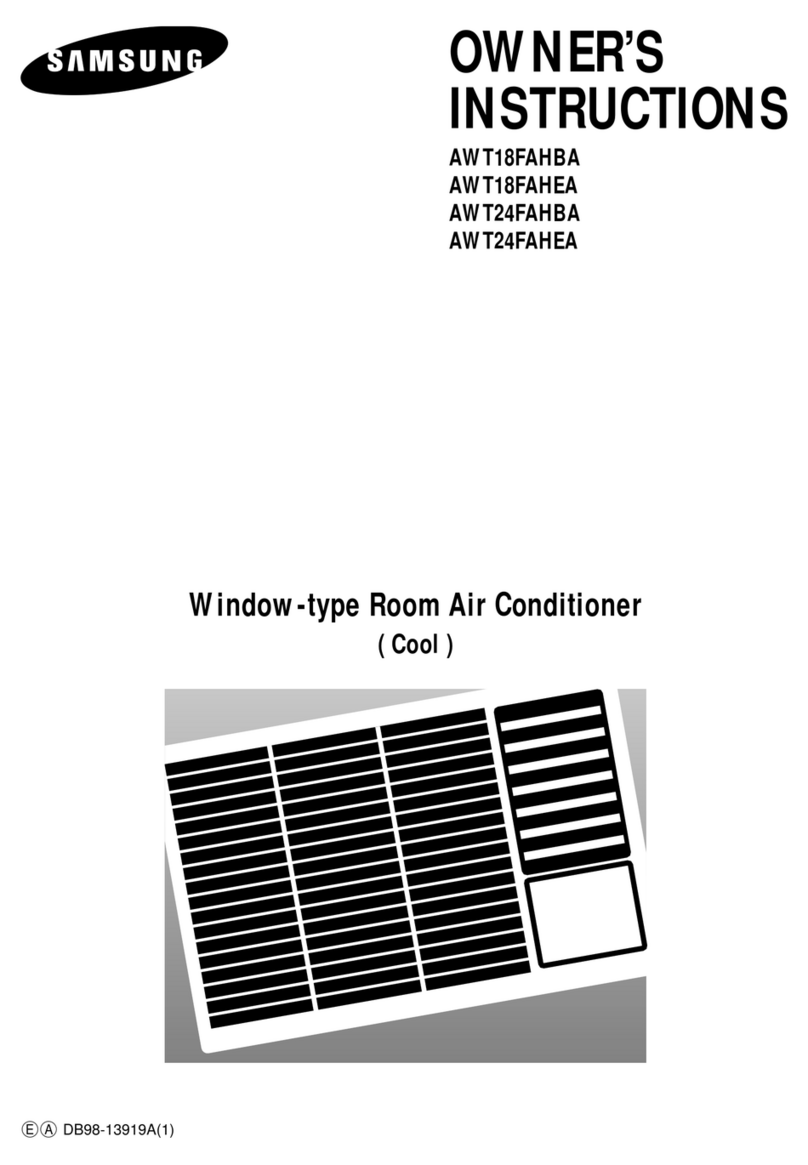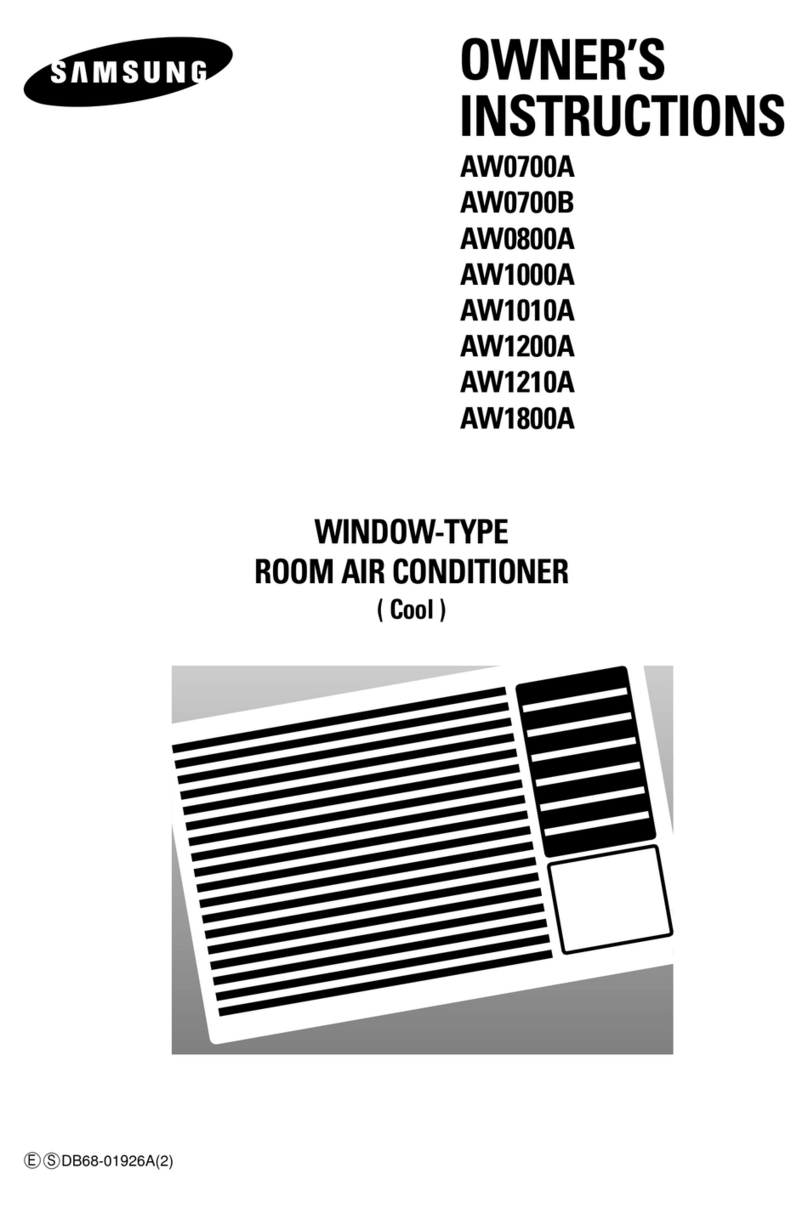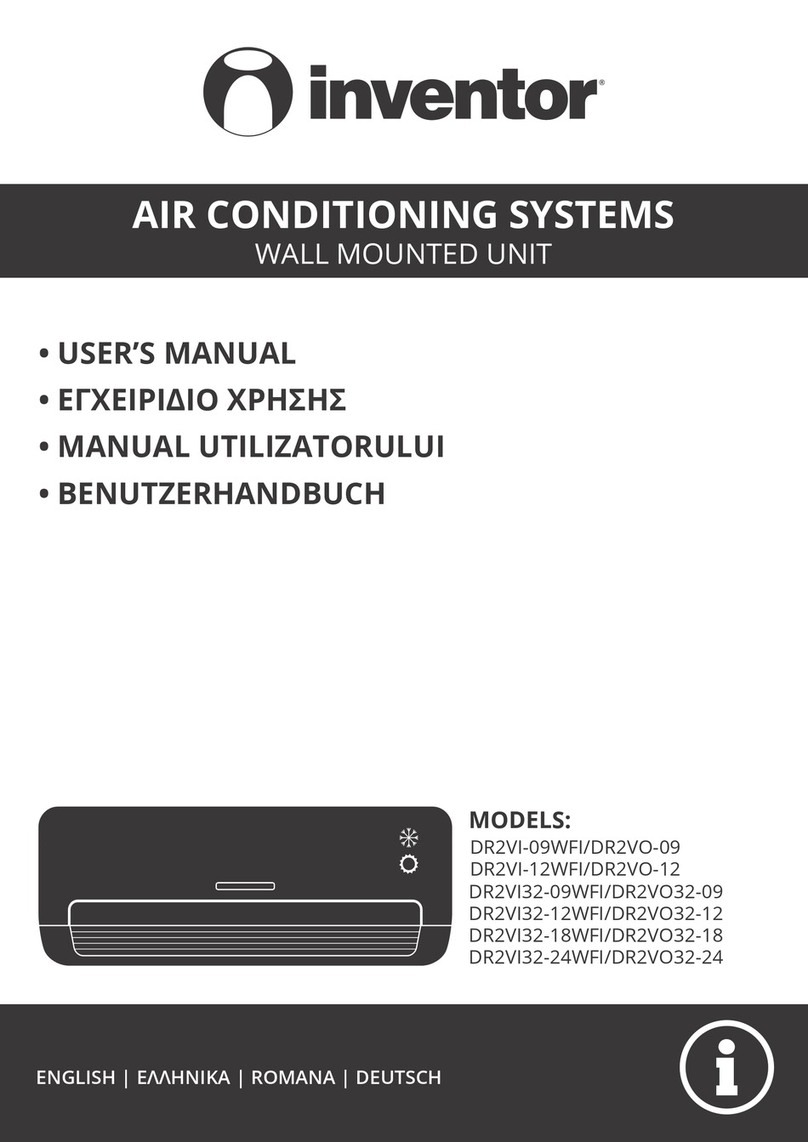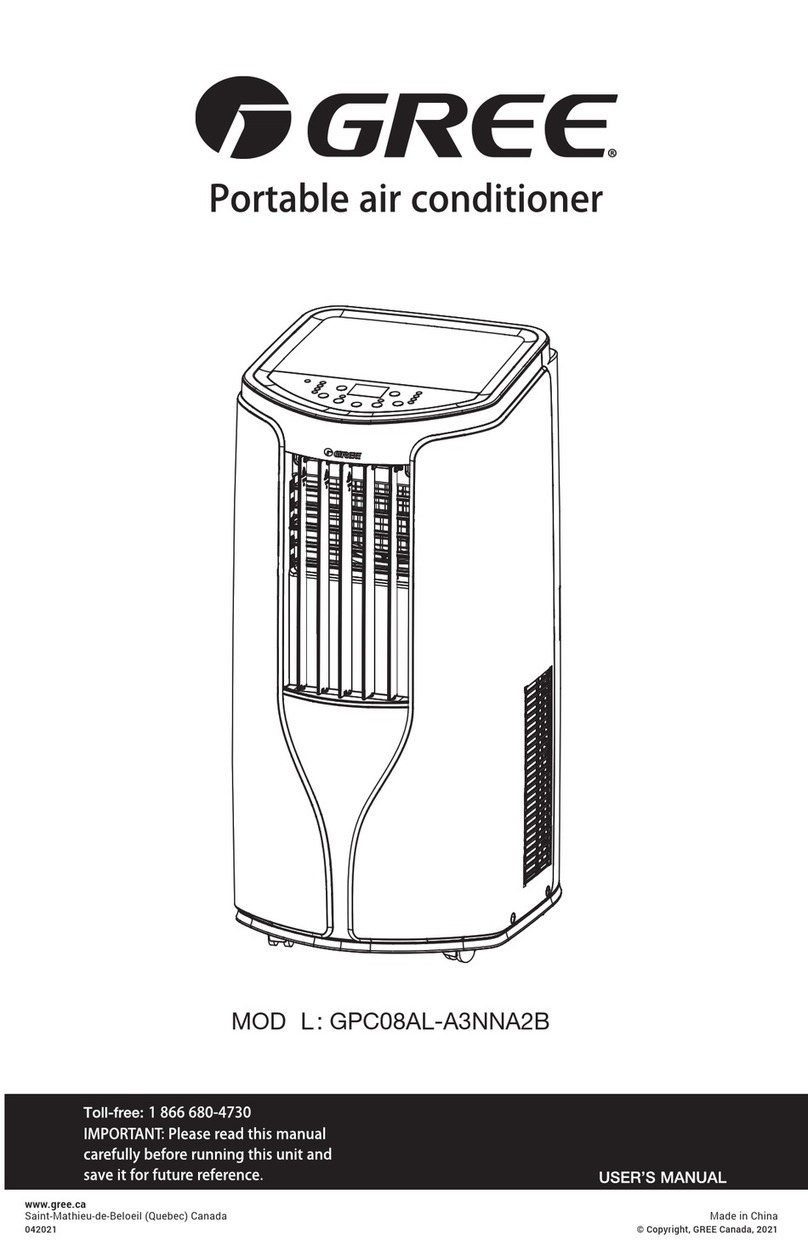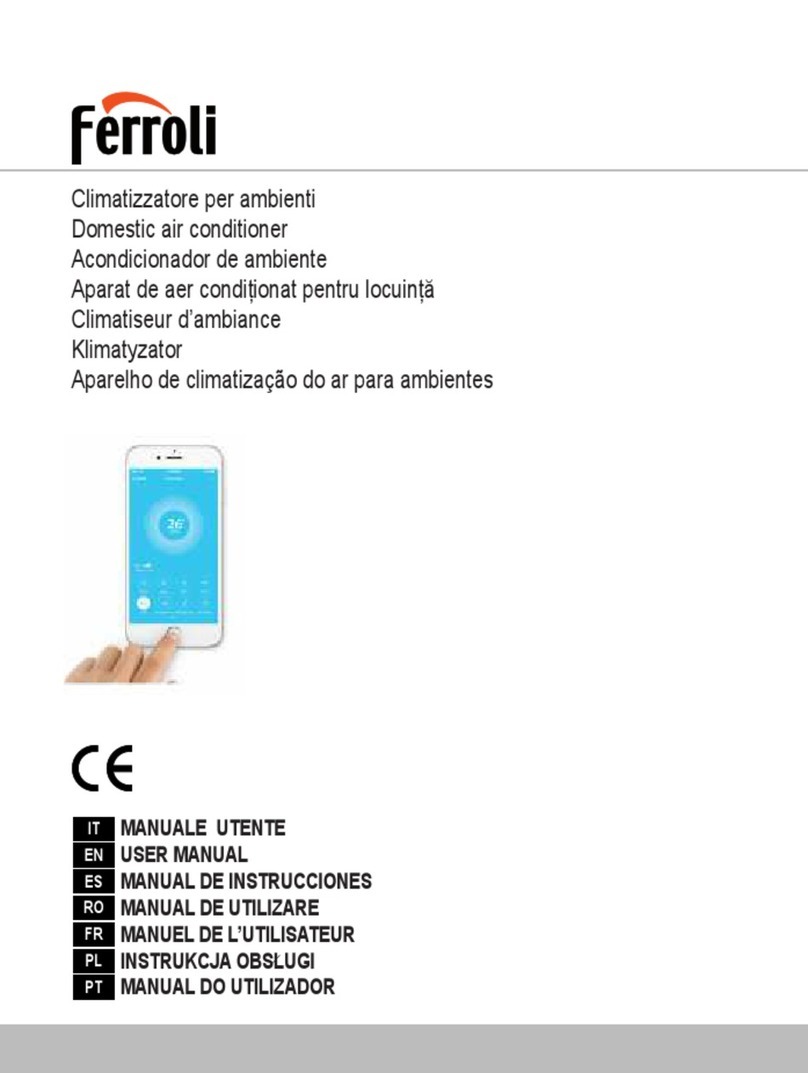Rivacold RS Series Manual

RS REV. 08 04/10
I
UK
MANUALE USO E MANUTENZIONE
AEROEVAPORATORI A SOFFITTO
USE AND MAINTENANCE HANDBOOK
CEILING UNIT COOLERS
RS

RS Pag. 2 REV. 08 04/10

RS Pag. 3 REV. 08 04/10
I
ITALIANO
SOMMARIO
1. Scopo del manuale
2. Norme di uso generale
3. Modo di identificazione della macchina
4. Installazione
5. Collegamento frigorifero
6. Collegamento scarico condensa
7. Installazione elettrica
8. Dati tecnici
9. Manutenzione e pulizia
10. Smaltimento
11. Guasti - cause e rimedi
12. Optional
pag. 3
pag. 3
pag. 4
pag. 5
pag. 6
pag. 6
pag. 7
pag. 8
pag. 8
pag. 8
pag. 8
pag. 9
1. SCOPO DEL MANUALE
Il presente manuale ha lo scopo di aiutare l’operatore nella corretta messa in funzione
dell’evaporatore, chiarire le relative norme di sicurezza vigenti nella comunità europea ed eliminare
eventuali rischi da errati utilizzi.
2. NORME DI USO GENERALE
•Per un utilizzo corretto e sicuro della macchina, è necessario attenersi alle prescrizioni contenute
nel presente manuale in quanto fornisce istruzioni e indicazioni circa:
9modalità di installazione
9uso della macchina
9manutenzione della macchina
9smaltimento e messa fuori servizio
•Il costruttore non risponde per danni derivanti dalla inosservanza delle note e avvertenze contenute
nel presente libretto di istruzioni.
•Leggere attentamente le etichette sulla macchina, non coprirle per nessuna ragione e sostituirle
immediatamente in caso venissero danneggiate.
•Conservare con cura il presente manuale.
•Il costruttore si riserva di aggiornare il presente libretto senza nessun preavviso.
•Gli aeroevaporatori sono realizzati per la sola refrigerazione industriale e commerciale in sede
stabile. Non sono consentiti usi diversi da quello destinato.Ogni altro uso è considerato improprio
e quindi pericoloso.
•Dopo aver tolto l’imballo assicurarsi che la macchina sia intatta in ogni sua parte, in caso
contrario rivolgersi al rivenditore.
•E’ vietato l’utilizzo della macchina in ambienti con presenza di gas infiammabile e in ambienti con
rischio di esplosione.
•Non lavare la macchina con getti d’acqua diretti o in pressione, o con sostanze nocive.
•Non usare la macchina priva di protezioni (carenatura e griglia)
•Evitare che la macchina sia esposta a fonti di calore.
•In caso di incendio usare un estintore a polvere.
•Il materiale dell’imballaggio deve essere smaltito nei termini di legge.
3. MODO DI IDENTIFICAZIONE DELLA MACCHINA
Tutte le macchine sono provviste di relativa etichetta di riconoscimento (la posizione è indicata in Fig.
1) in cui sono riportati i seguenti dati:
•codice
•n° motoventilatori – n° giri (RPM)
assorbimento in Watt (W)
assorbimento in ampere (A)
tensione di alimentazione (Volt/Ph/Hz)
•sbrinamento:
n° di resistenze
assorbimento in Watt (W)
tensione di alimentazione (Volt/Ph)
•gruppo fluido refrigerante :Gruppo 2 (*)
•pressione PS (pressione massima di lavoro)
•temperatura TS (temperatura minima di
esercizio)
•matricola

RS Pag. 4 REV. 08 04/10
I
(*) Secondo la normativa EN 378/1 appartengono al Gruppo 2 i seguenti gas :
R22,R134a,R507,R404A,R407C,R410A,R410B
Tutti gli evaporatori RS rientrano nella categoria 0 secondo la direttiva 97/23/CE (P.E.D.)
Fig. 1
* Valvola termostatica con equilibrio esterno
Identificazione della matricola:
•cifra 1 e 2 = ultime due cifre dell’anno di costruzione
•cifra 3 e 4 = settimana dell’anno in cui è stata prodotta la macchina
•cifre 5,6,7e 8 = numero progressivo
4. INSTALLAZIONE (Note generali)
L’installazione deve essere eseguita da personale qualificato, in possesso dei requisiti tecnici
necessari stabiliti dal paese dove viene installata la macchina.
Per la movimentazione della macchina, usare guanti di protezione antitaglio o sistema di
sollevamento idoneo.
Assicurarsi che la struttura su cui andrà fissato l’RS, sia adeguata al suo peso.
Non canalizzare l’aria dei motoventilatori per non aumentare le perdite di carico.
Condizioni particolari di funzionamento come celle troppo basse, stoccaggi eccessivi, ostacoli al getto
d’aria, possono influenzare le prestazioni dichiarate.
4. 1 Montaggio valvola termostatica (non fornita):
Dimensionare opportunamente la valvola termostaticha (N.B. - per i modelli RS3180-RS3180B-
RS3290-RS3290B-RS4380-RS4380B deve essere utilizzata una valvola termostatica con equilibrio
esterno e con l’uscita a flangiare).
Aprire la macchina come mostrato in Fig. 3, allentando le viti A e svitando le viti di fissaggio B.
B
P1
42
40
120 min
50
A/2
26
119
A
P2
67
ETICHETTA
22
4
32
6
13
Particolare Fissaggio
A/2
26
119
A
P2
67
P3
P1
P2
P3
A
B
entrata
scarico
Attacco scarico
Peso vers.normale 4,0 3,9 4,6 4,5 6,7 6,6 7,3 7,2 10,5 10,4 11,5 11,4 16,5 16,3
(Kg) vers.ED - 4,2 - 4,8 - 7,0 - 7,6 - 11,0 - 12,0 - 17,1
Modello RS 1040 1040B 1060 1060B 2100 2100B 2130 2130B 3180* 3180B* 3290* 3290B* 4380* 4380B*
(mm)
Dimensioni
Attacchi batteria
175
270
-
404
360
ø9,52
ø9,52
ø20mm
190 190 190
-
404
433
ø9,52
ø9,52
ø20mm
190 190 190
270 970470470
ø20mm ø20mm ø20mm ø20mm ø20mm
ø9,52
ø9,52 ø9,52
ø9,52 1/2"SAE
16mm 1/2"SAE
16mm 1/2"SAE
16mm
----622,5
604
433 604
433 1104
433 1104
433 1379
433
1245970

RS Pag. 5 REV. 08 04/10
I
Sul tubo di ingresso dell’evaporatore, collegare l’uscita della valvola termostatica (Fig. 2 Part.A).
Solo per i modelli RS3180-RS3180B-RS3290-RS3290B-RS4380-RS4380B, predisporre il tubo
dell’equilibrio esterno che dovrà essere saldato sulla valvola termostatica e sul collettore
dell’evaporatore, nella posizione mostrata in Fig. 2 Part. B. Posizionare il bulbo della valvola
termostatica sul tubo di aspirazione, immediatamente prima del tubo dell’equilibrio esterno, se
presente (Fig. 2 Part.C) Fissare il bulbo sul tubo di aspirazione con delle fascette metalliche. Saldare
sull’ingresso della valvola termostatica, un tubo opportunamente piegato in precedenza (Fig. 2 Part
D). Il tubo uscirà dall’evaporatore attraverso il foro predisposto e sarà collegato successivamente alla
tubazione del liquido dell’impianto frigorifero.
Fig. 2
4. 2 Posizionamento a soffitto
Una volta fissata la valvola termostatica, fissare l’evaporatore al soffitto della cella.
La macchina deve essere installata solo in posizione orizzontale, utilizzando le apposite asole di
fissaggio. Gli interassi di fissaggio e la posizione delle ventole rispetto alle pareti della cella, è
mostrata in Fig. 1.
Lasciare intorno alla macchina sufficiente spazio per permettere un buon ricircolo dell’aria e per
effettuare le manutenzioni in condizioni di sicurezza. La distanza minima consigliata del lato motore
dalla parete, è di 120mm (Fig. 1).
Per il montaggio, aprire la macchina come mostrato in Fig. 3, allentando le viti A e svitando le viti di
fissaggio B.
Fissare la macchina utilizzando le 4 apposite asole sulla carenatura.
Per montare la resistenza di sbrinamento, posizionarla negli appositi scavi ricavati sopra la batteria e
fissarla con le due molle (G) fornite in dotazione.
Procedere con i collegamenti, frigorifero ed elettrico descritti nei paragrafi successivi.
Riposizionare il convogliatore e serrare le viti B ed A, come mostrato in Fig.3.
Collegare il tubo di scarico condensa al bocchettone F (fornito in dotazione).
5. COLLEGAMENTO FRIGORIFERO
Collegare l’uscita dell’evaporatore sull’aspirazione dell’impianto frigorifero (è buona regola
realizzare un sifone).
Collegare il tubo che precedentemente era stato saldato all’ingresso della valvola termostatica, alla
tubazione del liquido dell’impianto frigorifero.
Per garantire una buona tenuta ermetica e ridurre i rischi di rottura, eseguire tutte le giunzioni tramite
saldatura a “bicchiere”. Se il diametro dei tubi non lo consente, utilizzare dei giunti a saldare idonei.
Durante le fasi di collegamento tubazioni, fare attenzione a non forzare o modificare la posizione del
collettore in quanto si potrebbero favorire rotture.
6. COLLEGAMENTO SCARICO CONDENSA
La tubazione per lo scarico dell’acqua di condensa, và collegata all’attacco maschio da 1/2”Gas
situato al centro della vasca di raccolta (la pendenza minima deve essere superiore al 20%).
Predisporre sulla parete della cella in prossimità dell’evaporatore, un foro attraverso il quale la
tubazione uscirà per arrivare in un pozzetto a sifone. Sigillare il foro con silicone (di caratteristiche
idonee all’uso della cella) onde evitare infiltrazioni di aria calda. In caso di cella a temperatura

RS Pag. 6 REV. 08 04/10
I
negativa, la linea di scarico deve essere riscaldata durante il periodo di sbrinamento, con una
resistenza al silicone (optional) da circa 100W posta al suo interno.
Fig. 3
(*) Nota: solo per modelli RS….B e RS….BED
7. INSTALLAZIONE ELETTRICA
Le operazioni di collegamento elettrico, devono essere eseguite da personale qualificato in possesso
dei requisiti tecnici necessari stabiliti dal paese dove viene installata la macchina
•Predisporre opportuni sistemi di protezione sulla linea di alimentazione ed accertarsi che la
tensione corrisponda a quella indicata sull’etichetta applicata sulla macchina (tolleranza
consentita ± 10% della tensione nominale).
•E’ obbligatorio, a termini di legge, collegare la macchina ad un efficiente impianto di messa a
terra. Si declina ogni responsabilità dall’inosservanza di tale disposizione e qualora l’impianto
elettrico a cui ci si allaccia non sia realizzato secondo le norme vigenti.
•Sugli evaporatori dotati di resistenze di sbrinamento, va installato un termostato meccanico tarato
a 40°C che disabilita le resistenze in caso di sovratemperatura. Il bulbo del termostato va
posizionato nel pacco alettato nel punto più alto dell’evaporatore.
7. 1 Collegamento elettrico
Collegare i motori e la resistenza all’alimentazione, utilizzando per il passaggio dei cavi, i prefori
laterali già predisposti.
Solo nel modello con codice RS….BED, di bassa con resistenze montate di serie, la resistenza ed i
motori sono già collegati su di una scatola di derivazione, secondo lo schema elettrico di Fig.4.
Tutti i modelli hanno motoventilatori alimentati con una tensione 220-240V/1Ph/50-60Hz, sui
modelli ED sono presenti le resistenze di sbrinamento alimentate 230V/1Ph/50-60Hz (vedi Fig. 4).
A
B C
A
E
Controgocciolatoio (*)
Carenatura
Convogliatore
Resistenza di
sbrinamento solo
su modelli BED
Batteria
G G
E
B C F

RS Pag. 7 REV. 08 04/10
I
L2
N2
L1
N1
R
MMMM
Fig. 4
RSModello
RS…B 1040 - 1060 2100 - 2130 3180 - 3290 4380
Motoventilatori nxømm 1x200 2x200 3x200 4x200
A 0.25 0.50 0.75 1
Assorbimento motoventilatori W 43 86 129 172
Assorbimento resistenze* W 400 600 - 650 1000 1300
* Le resistenze sono fornite montate e cablate, solo nei modelli RS….BED
I motori sono dotati di un sistema di protezione interna a riarmo automatico.
Se si intende utilizzare un sistema di regolazione del numero di giri del motoventilatore,
accertarsi che sia compatibile con il motoventilatore stesso.
8. DATI TECNICI
Gli aeroevaporatori RS sono equipaggiati con motoventilatori assiali non adatti per prevalenze
aggiuntive.
Lo scambiatore di calore è in rame-alluminio, quindi non adatto ad essere impiegato in ambienti
aggressivi.
9. MANUTENZIONE E PULIZIA
La manutenzione e pulizia devono essere eseguite solamente da tecnici specializzati.
Prima di qualsiasi operazione si deve verificare che la corrente elettrica sia disconnessa.
•Controllare il serraggio di tutti i morsetti all'interno della scatola di derivazione ( frequenza
quadrimestrale)
•Controllare visivamente tutto il circuito frigorifero, anche internamente alle macchine, alla ricerca
di perdite di refrigerante, che sono denunciate anche da tracce di olio lubrificante. Intervenire
tempestivamente e approfondire in caso di dubbio. (frequenza quadrimestrale)
•Pulire periodicamente l’evaporatore per evitare l’accumulo di sostanze nocive . Si consiglia l’uso
di acqua e sapone, evitando solventi, agenti aggressivi, abrasivi o a base di ammoniaca.
•In caso di sostituzione di componenti della macchina essi devono essere sostituiti con componenti
identici agli originali
Importante: al termine della manutenzione, riposizionare tutte le protezioni rimosse (carenatura e
griglia).
10. SMALTIMENTO
Qualora la macchina sia messa fuori servizio, è necessario scollegarla dall’impianto elettrico. Il gas
contenuto all’interno dell’impianto non deve essere disperso nell’ambiente.
M= motoventilatori
R= Resistenza di sbrinamento
220-240
V
/1Ph/50-60Hz 230V/1Ph/50-60Hz

RS Pag. 8 REV. 08 04/10
I
11. GUASTI Cause – rimendi
Problema Causa possibile Rimedio
Durata fase sbrinamento troppo breve. Aumentare il tempo di sbrinamento.
Intervallo tra due sbrinamenti troppo
lunghi.
Aumentare i cicli di sbrinamento.
Verificare eventuali tubi schiacciati.
Tempo di sgocciolamento insufficiente. Verificare il tempo di sgocciolamento
impostato.
Infiltrazione dell’aria attraverso la porta,
aperta troppo frequentemente.
Ridurre la frequenza di apertura ed
eliminare eventuali fessure
Evaporatore
ghiacciato
Resistenze elettriche bruciate. Sostituire le resistenze guaste.
L’afflusso del refrigerante all’evaporatore
è ridotto.
Controllare dimensionamento valvola
termostatica
Orifizio della valvola termostatica troppo
piccolo.
Aumentare il diametro dell’orifizio.
Evaporatore
ghiacciato solo
vicino alla
valvola
termostatica Surriscaldamento elevato. Controllare le temperature ed agire sulla
valvola.
Evaporatore
danneggiato
Alette deformate. Raddrizzare le alette con un pettine.
Motore ventilatore guasto. Sostituzione.
Ventilatori
bloccati Tensione di linea inferiore ai limiti di
tolleranza.
Verificare il valore della tensione con un
voltmetro.
12. OPTIONAL
Batteria verniciata con vernice a polvere epossidica
La verniciatura della batteria, protegge la stessa dagli agenti corrosivi che possono essere presenti
nella cella.
Resistenze sbrinamento
In tutti i modelli, tranne nei modelli RS….BED (dove la resistenza è già montata e collegata in scatola di
derivazione), la resistenza di sbrinamento viene fornita su richiesta (a corredo)
Resistenza per il tubo di scarico
Si utilizza quando la cella dove è installato l’aeroevaporatore, lavora a temperatura negativa.
Deve essere inserita all’interno del tubo di scarico dell’acqua di condensa, in modo che l’acqua
formatasi durante lo sbrinamento, non congeli all’interno dello scarico.

RS Pag. 9 REV. 08 04/10
UK
ENGLISH
Contents
1. Handbook purpose
2. Norms for general use
3. Machine identification
4. Installation
5. Refigerating connection
6. Condensate discharge connection
7. Electrics installation
8. Technical data
9. Maintenance and cleaning
10. Disposal
11. Failures and solutions
12. Optional items
pag. 10
pag. 10
pag. 11
pag. 12
pag. 13
pag. 13
pag. 14
pag. 15
pag. 15
pag. 15
pag. 15
pag. 16
1. HANDBOOK PURPOSE
This handbook is issued in order to assist an operator properly to bring the unit cooler on stream ,
give explainations about the relevant safety norms in force within the European Community and avoid
any risks that may be caused by a wrong usage.
2. NORMS FOR GENERAL USE
•For a correct and safe use of the machine, it is necessary to follow the prescriptions present in this
manual as it gives instructions and information about :
9installation
9use
9maintenance
9disabling and disposal
•The manufacturer cannot accept any liability for damages resulting from failure to follow the
prescriptions and advice given in this handbook.
•Read carefully labels placed on the machine, do not cover them for any reason and replace them
in case they are damaged .
•Keep this manual carefully.
•The manufacturer may review this manual at any time, without notice.
•The unit coolers are designed for the use in industrial and commercial refrigeration application for
stable cold rooms. They are not intended for any other purpose.Any other use is to be considered
improper and dangerous .
•When the package is removed, please check that every part of the machine is intact; if not, contact
the retailer immediately .
•It is forbidden the use of the machine in environment with presence of inflammable gas or where
there is a risk of explosion.
•Do not clean the machine with direct water jet, under pressure or with improper substances .
•Do not use the machine without its protections ( housing and grid)
•Do not expose the machine to heating sources
•In case of fire use a powder fire extinguisher
•Packaging material must be suitably disposed of according to the low in force
3. MACHINE IDENTIFICATION
All the machines are equipped with an identifying label (the position of the label is shawn in Drawing
1) where the following data are quoted :
•code
•no. of fan motors - no. of revolutions(RPM)
Watt absorption (W)
Ampere absorption (A)
Power supply voltage (Volt/Ph/Hz)
•defrosting:
heaters number
Watt absorption(W)
power supply voltage (Volt/Ph)
•refrigerant group: Group 2(*)
•PS pressure (max working pressure)
•TS temperature (min. operating temp.)
•serial number
(*) According to EN378/1 norm belong to the group 2 the following gas types:

RS Pag. 10 REV. 08 04/10
UK
R22,R134a,R507,R404A,R407C,R410A,R410B
All RS range unit coolors belongs to CAT 0 in conformity with the 97/23/CE (P.E.D.) directive.
Drawing 1
*Thermostatic valve with external equaliser;
Serial number designation :
•number 1 and 2 = last two numbers of the manufacturing year
•number 3 and 4 = week of the year when the unit was manufactured
•numbers 5,6,7and 8 = progressive number
4. INSTALLATION (general notes)
Installation must be carried out by qualified personnel having the necessary technical requirements
asked for by the country where the machine is to be installed.
For moving the machine use safety anti-cut gloves and suitable hoisting device.
Check that the structure where the RS is going to be fixed is suitable to its weight .
Do not convey the motor fan air in order not to increase load losses.
Particular operating conditions such as cold rooms having too small height, excessive loading ,
obstacles to the air flow, may have an influence to the stated performances .
4. 1 Thermostatic valve mounting (not supplied)
The thermostatic valve is to be properly sized (NOTE: for models RS3180-RS3180B-RS3290-RS3290B-
RS4380-RS4380B it is necessary to use a thermostatic valve with external equaliser and outlet to be
B
P1
42
40
120 min
50
A/2
26
119
A
P2
67
ETICHETTA
22
4
32
6
13
Fastenin
g
detail
Identif
y
in
g
label
A/2
26
119
A
P2
67
P3
P1
P2
P3
A
B
inlet
outlet
Drain connection
Weight Without ED 4,0 3,9 4,6 4,5 6,7 6,6 7,3 7,2 10,5 10,4 11,5 11,4 16,5 16,3
(Kg) With ED - 4,2 - 4,8 - 7,0 - 7,6 - 11,0 - 12,0 - 17,1
ø20mm ø20mm ø20mmø20mm ø20mm ø20mm ø20mm
ø9,52 16mm 16mm 16mm
ø9,52 1/2"SAE 1/2"SAE 1/2"SAE
Coil connections ø9,52 ø9,52 ø9,52
ø9,52 ø9,52 ø9,52
433 433 433 433
604 1104 1104 1379
(mm) 404 404 604
360 433 433
- - - 622,5
470 970 970 1245
190 190 190 190
Dimensions 175 190 190
270 270 470
---
3290* 3290B* 4380* 4380B*2130 2130B 3180* 3180B*1060 1060B 2100 2100BModel RS 1040 1040B

RS Pag. 11 REV. 08 04/10
UK
flanged).
Open the machine, as illustrated in Drawing 3, loosening the screws A and unscrewing the fastening
screws B. Connect the thermostatic valve outlet to the evaporator inlet pipe (Drawing 2, point A).
For models RS3180-RS3180B-RS3290-RS3290B-RS4380-RS4380B only: fit the external equaliser
pipe, which must be welded to the thermostatic valve and to the evaporator manifold, in the position
shown in Drawing 2, point B. Place the thermostatic valve bulb on the suction pipe, just before the
external equaliser pipe, if fitted (Drawing 2 point. C). Fix the bulb on the suction pipe by means of
metal clamps.
Solder on the inlet side of the thermostatic valve, a pipe , previously bent in the proper way, (see
Drawing 2 ; Part D). The pipe will come out from the cooler through the preset hole and will be
connected then to the liquid pipe of the refrigerating system.
Drawing 2
4. 2 Positioning on the ceiling
Once the thermostatic valve is connected, fix the unit cooler to the cold room ceiling.
The unit has to be installed in horizontal position, only by means of the proper fixing slots. The fixing
distances between centers and the position of the fans relating to the cold room walls is shown in
Drawing 1. Keep around the unit enough space for a good air cycling and for a maintenance
operation in safe conditions. The minimum recommended distance from the wall for the motor side is
120 mm (Drawing 1). To assemble, open the machine, as illustrated in Drawing 3, loosening the
screws A and unscrewing the fastening screws B. Fix the machine, using the 4 special slots in the
casing. To fit the defrosting heater, place it in the relevant notches above the coil and fix it into place
using the two springs (G) (supplied).
Proceed to make the refrigerating and electrical connections, as described in the following
paragraphs.
Reposition the conveyor and tighten the screws B and A, as shown in Drawing 3.
Connect the condensation discharge pipe to the pipe union F (supplied).
5. REFRIGERATING CONNECTION
Connect the evaporator outlet to the refrigerating system suction-pipe (we recommend fitting a
siphon).
Connect the pipe that was previously soldered to the inlet side of the thermostatic valve to the liquid
piping of the refrigerating system.
In order to guarantee a good hermetic seal and reduce break risks, execute all the joints by means of
a “ bell type” welding . If the pipe diameter do not allow that , use proper soldering joints .
During the pipe connection procedure pay attention not to force or modify the position of the header
as this may a cause of breaks.
6. CONDENSATE DRAIN CONNECTION
The piping for the condensate water drain is to be connected to the 1/2” Gas male connection placed
at the centre of the drip tray (the minimum gradient must be over 20%) . Provide on the cold room
wall, next to the unit cooler, for a hole through which the pipe will come out leading to a siphon trap.
Seal the hole by means of silicon (the features of which will be suitable to the cold room use) in order
to avoid infiltration of warm air. In case of a low temperature cold room the draining line must to be

RS Pag. 12 REV. 08 04/10
UK
heated during defrosting time by means of a silicon heater (optional) of about 100W placed inside it .
Drawing 3
(*) Note: Only for RS….B and RS….BED models
7. ELECTRICAL INSTALLATION
The wiring must be carried out by qualified personnel having the necessary technical requirements
asked for by the country where the machine is to be installed.
•Provide for proper protection systems on the power supply line and check that the voltage
corresponds to that quoted on the label placed on the unit ( allowed tolerance ± 10% of the
rated tension).
•The law requires that the unit is earthed: therefore it is necessary to connect it to an efficient
earthing equipment. No liability whatsoever can be accepted if the above instruction requirement
is not complied with or if the electrical plant to which the unit is to be connected is not made by
following the law in force.
•For evaporators equipped with defrosting heaters, it is necessary to install a mechanical thermostat
(set to 40°C), which will disable the heaters in the event of excess temperature. The thermostat
bulb should be positioned in the fin coil, in the highest point of the evaporator.
Casing
Conveyor
Coil
Drip tray (*)
Defrosting
heaters only
for BED
model
E
E
C
B
F
C
B
A
A
G G

RS Pag. 13 REV. 08 04/10
UK
L2
N2
L1
N1
R
MMMM
7. 1 Electrical connection
Connect the motors and the heater to the power supply, using the cable ducts already partially made
in the sides. For the model with the model code RS….BED (low temperature) only, with heaters fitted as
standard, the heater and motors are already connected to a terminal board, as illustrated in the
wiring diagram in Drawing 4. All models have fan motors that are powered at 220-240V/1Ph/50-
60Hz; ED models are equipped with defrosting heaters that are powered at 230V/1Ph/50-60Hz (see
Drawing 4);
Drawing 4
RS
Model
RS…B 1040 - 1060 2100 - 2130 3180 - 3290 4380
Fan motors nxømm 1x200 2x200 3x200 4x200
A 0.25 0.50 0.75 1
Fan motor absorption W 43 86 129 172
Heater power* W 400 600 - 650 1000 1300
*Heaters are supplied already fitted and wired on RS….BED models only.
The fan motors are equipped with an internal protection system with automatic cutout.
In case there is the need of fitting a regulation system of fan motor number of revolutions , check that
it is suitable for the fan motor itself .
8. TECHNICAL DATA
RS unit coolers are equipped with axial fan motors which are not suitable for additional air pressure
drops
The heat exchanger is made of copper-aluminium; therefore it is not suited for being used in
aggressive ambient.
9. MAINTENANCE AND CLEANING
Maintenance and cleaning have to be carried out by qualified technical presonnel only .
Before any intervention make sure that the electrical feed is disconnected from the mains.
•Check the fastening of all terminals inside the terminal box (every four months)
•Visually check the refrigerating circuit completely, also inside the machines, in order to detect
refrigerant leaks, that are also put in evidence by traces of lubricant oil. Make a fast intervention
220-240
V
/1Ph/50-60Hz 230V/1Ph/50-60Hz
M= Fan motors
R= Defrosting heater

RS Pag. 14 REV. 08 04/10
UK
and further check in case of doubt . (every four month)
•Periodically clean the unit in order to avoid deposits of toxic substances. The use of water and
soap is recommended and avoid using solvents , aggressive agents , abrasive or ammonia-based
materials.
•In the event that machine parts need replacing, they have to be replaced by items exactly the
same to the originals ones
Important: once the maintenance is accomplished, replace all safeties previously removed (housing
and grid ).
10. DISPOSAL
In case the machine is to be disabled , it is necessary to disconnect it from the mains. The gas inside
the plant must not be dispersed in the environment.
11. FAILURES : Causes – solutions
Problem Possibile cause solution
Defrosting time too short Increase defrosting time.
Time Interval between two defrostings too
long
Increase defrosting cycles.
Check the possibile presence of
squashed pipes
Dripping time not long enough Check the set dripping time.
Air infiltration through the door which is
too frequently opened
Reduce the door opening frequency
and eliminate possibile fissure
Iced Evaporator
Burnt electrical heaters. Replace the faulty heaters .
The refrigerant inflow to the evaporator is
reduced .
Check the size of the thermostatic
valve.
The orifice of the thermostatic valve is too
little.
Increase the orifice diameter
Iced evaporator
only near the
thermostatic
valve High Overheating. Check the temperatures and operate
on the valve
Damaged
evaporator
Deformed finns Straighten the finns with a comb .
Fan motor breakdown. Replacement.
Blocked fan
motors Mains Tension lower than the allowed
limits.
Check the tension value by a voltmeter
.
12. OPTIONAL ITEMS
Coil painted with epoxy powder varnish
The varnishment gives the coil a protection from corrosive agent that can be present inside the cold
room.
Defrosting heater
All RS models , except for RS...BED ones ( where the heater is already fitted and wired in a terminal
box) the defrosting heater is being supplied not fitted and only upon specific request .
Discharge pipe heater
This is used when the cold room where the unit cooler is installed operates at a negative temperature.
It has to be inserted inside the condensation water drain pipe so that the water formed during
defrosting does not freeze inside the drain pipe.


S.r.l. - Costruzione Gruppi Frigoriferi e Accessori
Via Sicilia, 7 - 61020 Montecchio (PU) - Italy - Tel. +39 0721 919911- Fax +39 0721 490015
COD. 99215002
Table of contents
Languages:
Other Rivacold Air Conditioner manuals
Popular Air Conditioner manuals by other brands
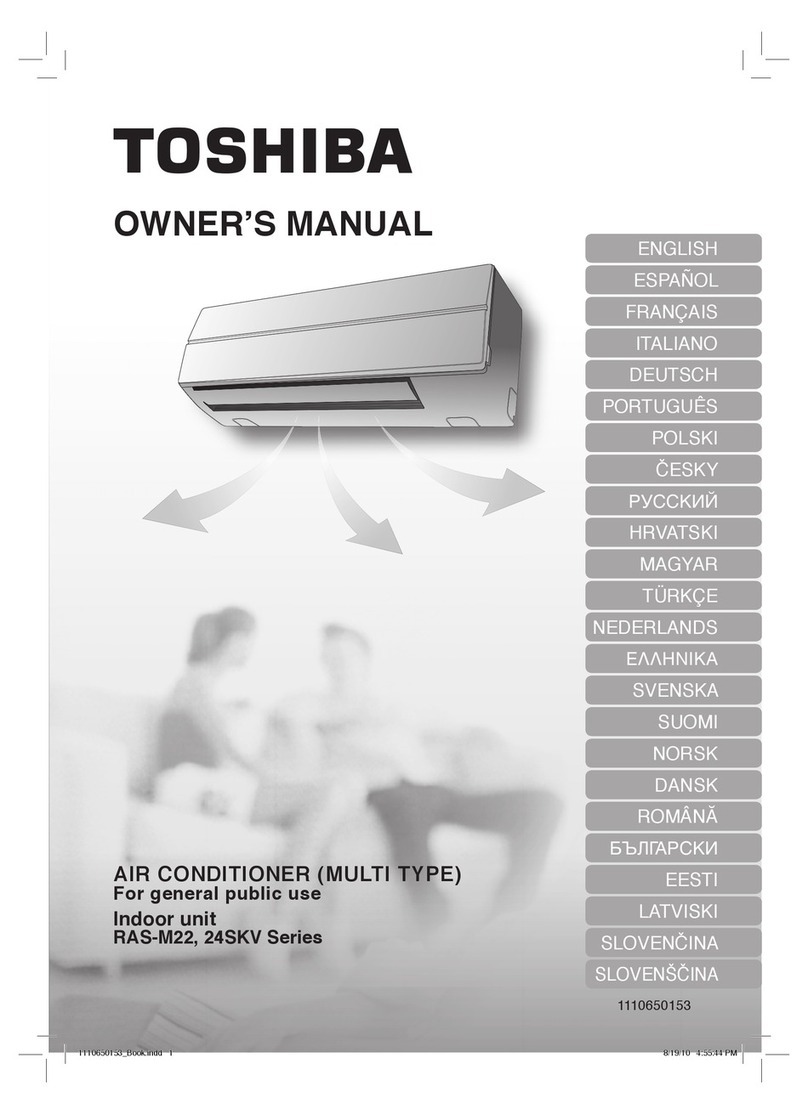
Toshiba
Toshiba RAS-M22 owner's manual

Mitsubishi Electric
Mitsubishi Electric PUMY-P36NKMU3 Technical & service manual

Emerson
Emerson Copeland ZXME-013E Application guidelines

Lennox
Lennox KGA092KGA102KGA120KGA150 installation instructions
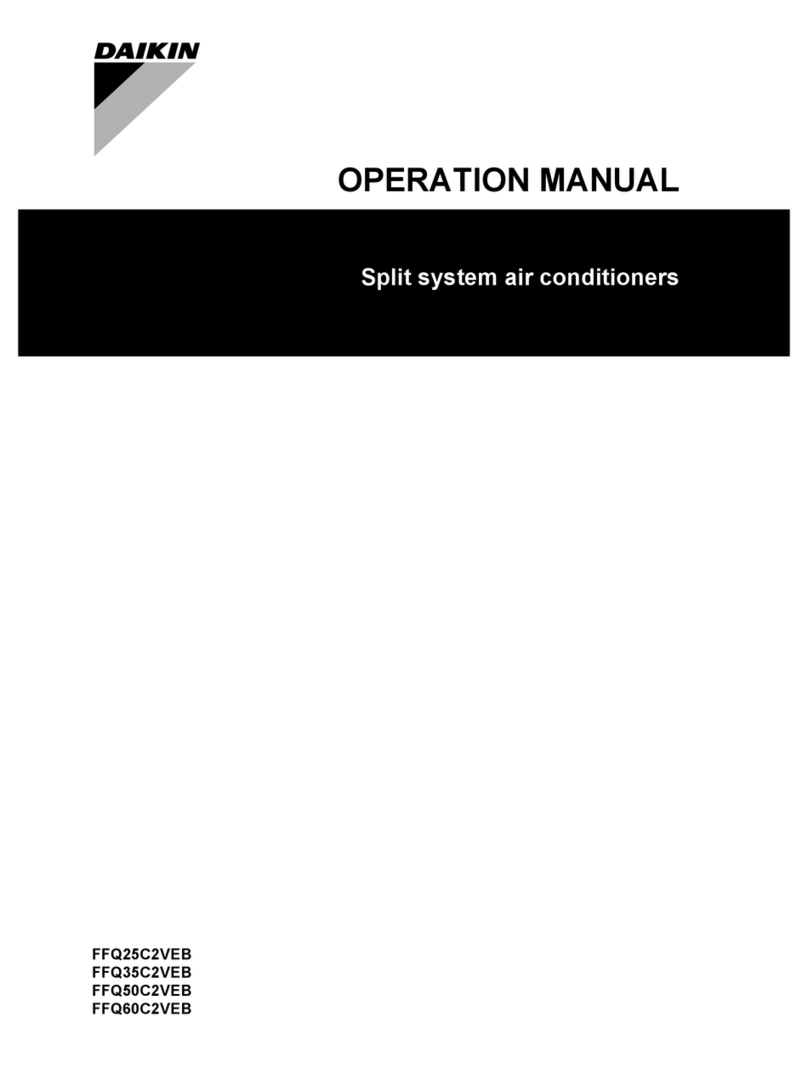
Daikin
Daikin FFQ25C2VEB Operation manual
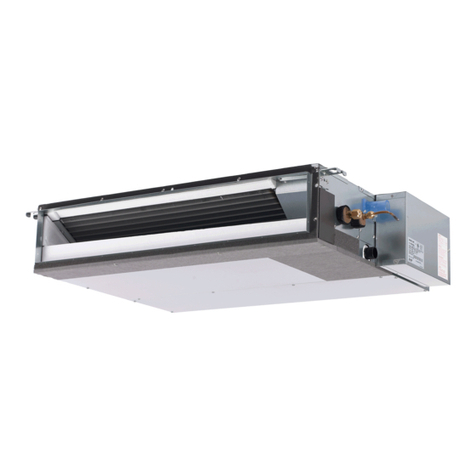
Mitsubishi
Mitsubishi Mr.Slim SEZ-KD09 Operation manual
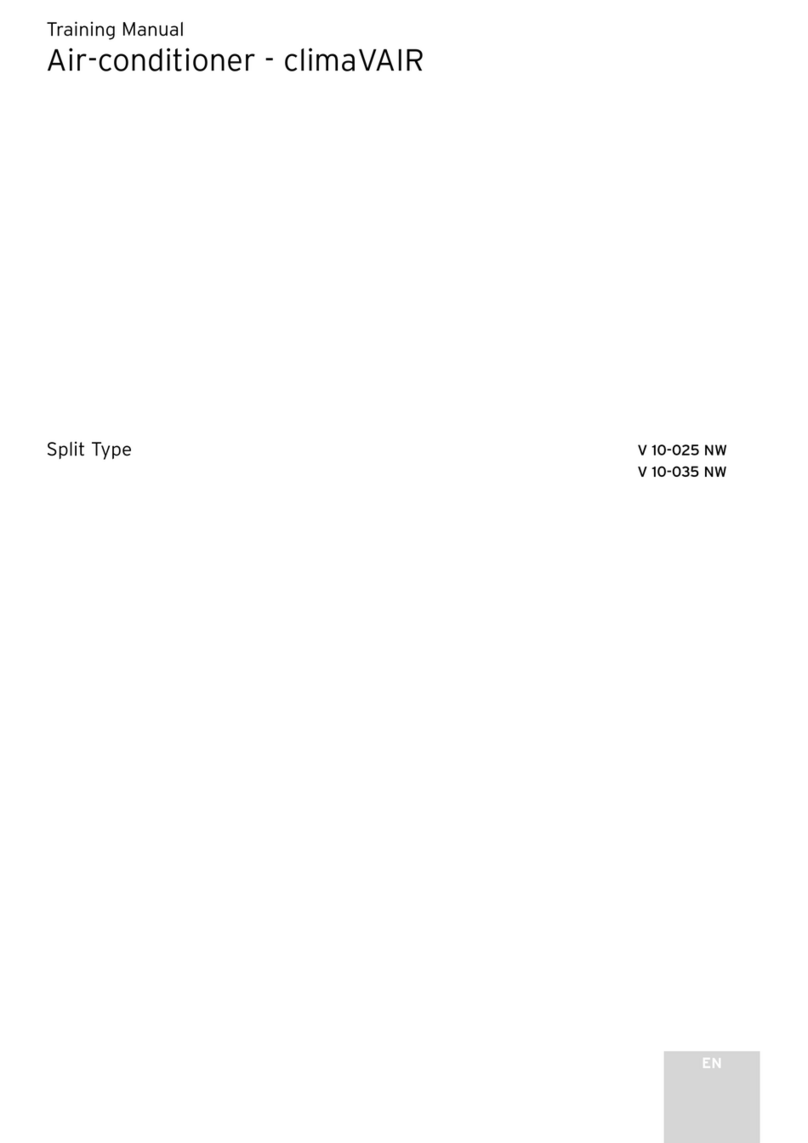
Vaillant
Vaillant V 10-025 NHI Training manual

LG
LG ZBNQ09GL1A0 Engineering product data book

Procool
Procool BG 10 CSA operating instructions
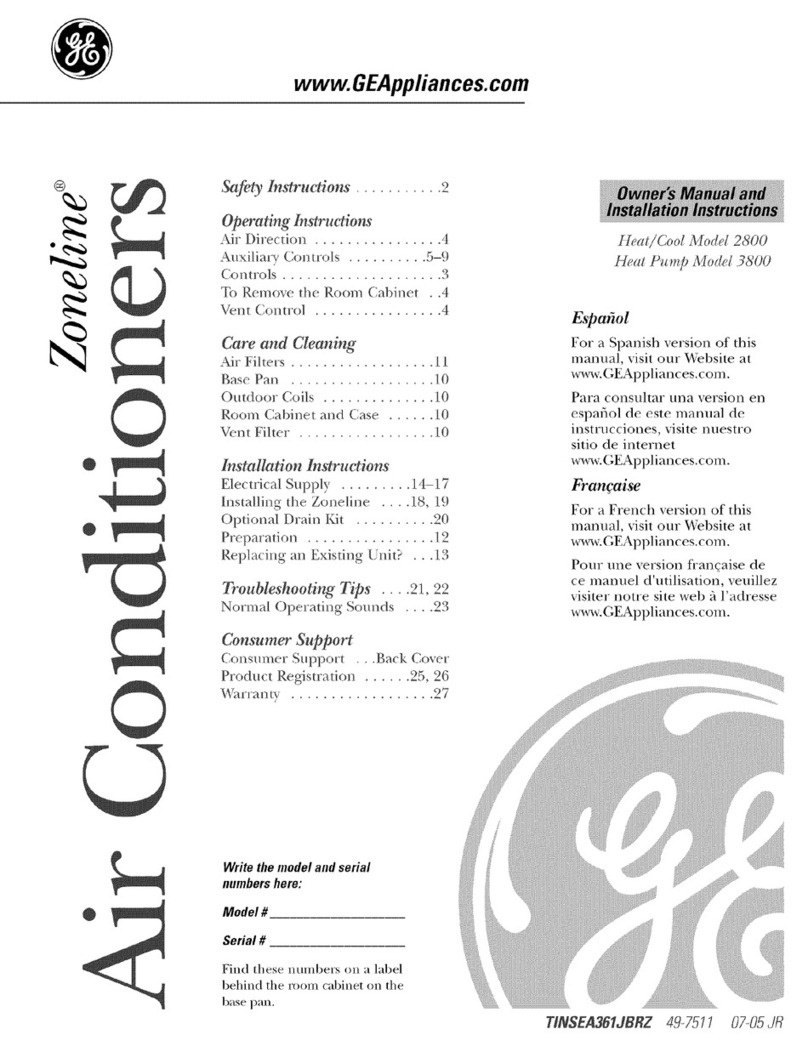
GE
GE AZ38H09EACM2 and Owner's manual and installation instructions
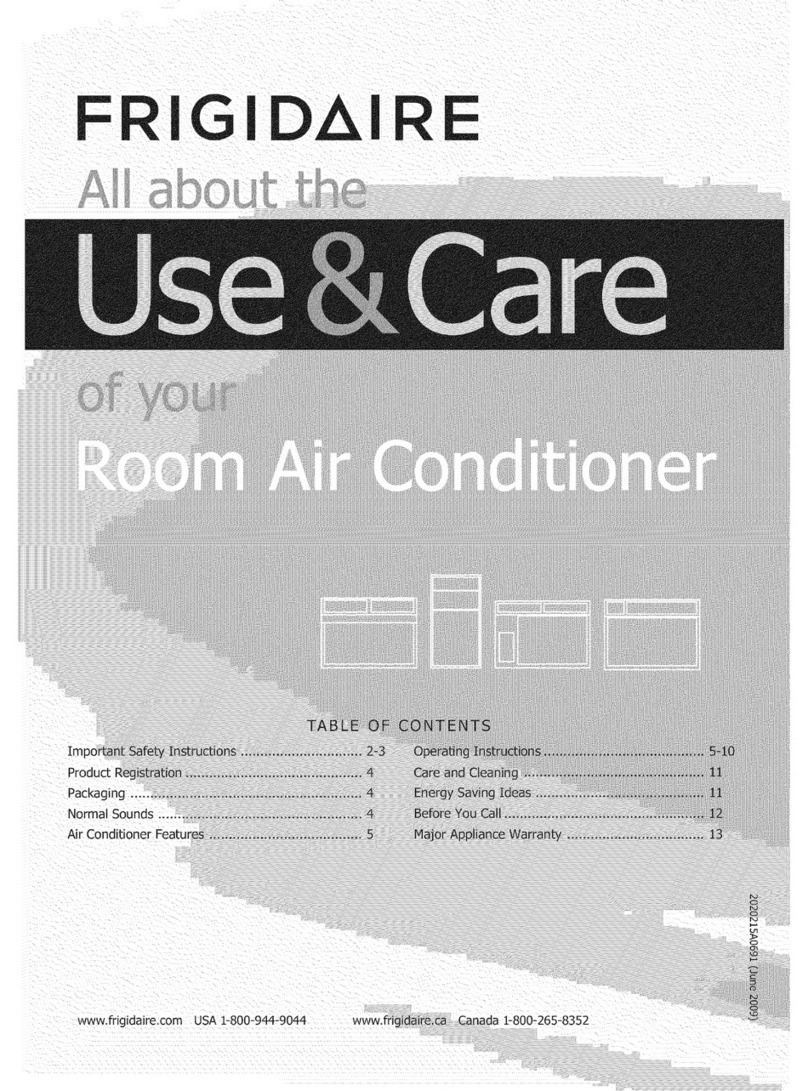
Frigidaire
Frigidaire FRA103BT113 Use & care guide
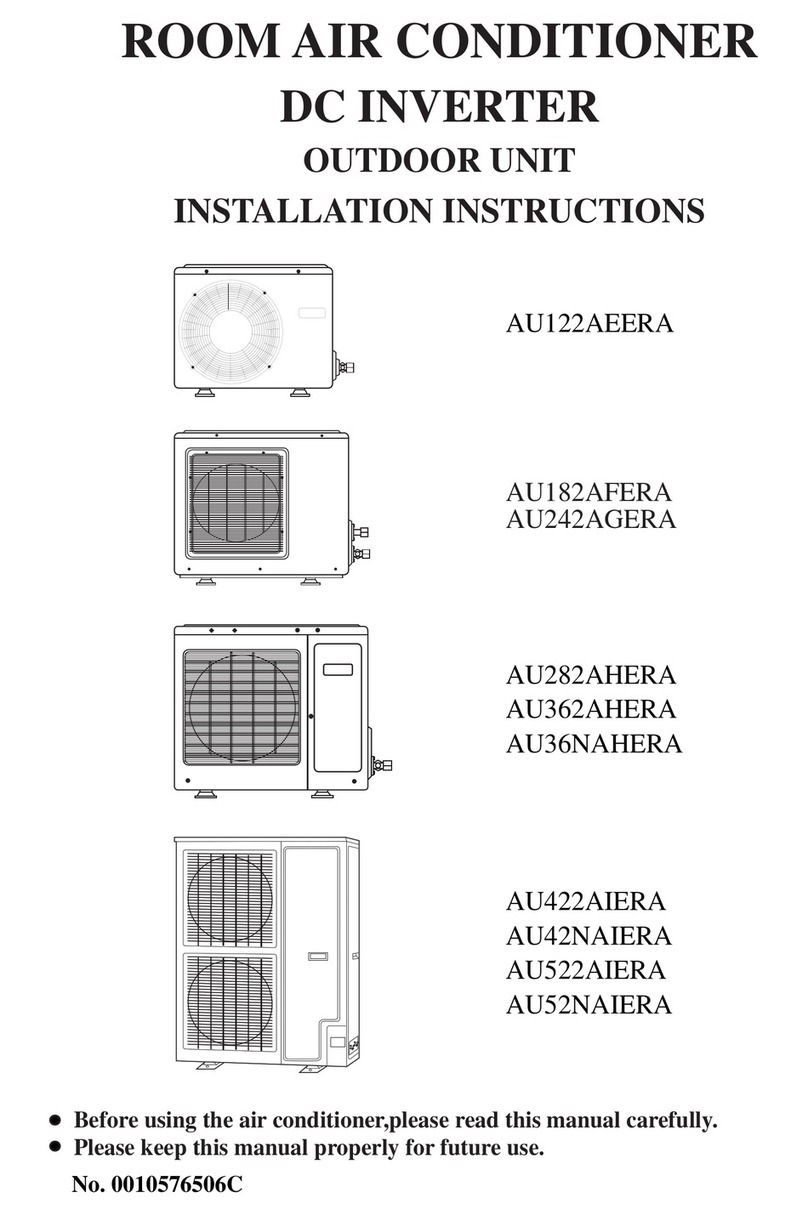
Haier
Haier AU182AFERA installation instructions



